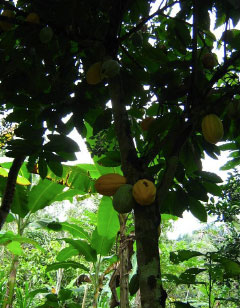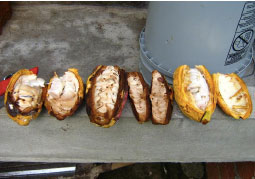As concern for the preservation of forest eco-systems in the tropics has increased over past decades, there has been a growing consideration for ways to harmonize tropical agricultural production with the surrounding environment. The idea of shade grown products, especially coffee and cacao, have become the focus of scientific study and of marketable interest for environmentally conscientious consumers. However, the practical and dependable nature of the practice of shade growing for farmers and conservation objectives is still the matter of some debate.

A cacao tree; the yellow pods are ready for harvest |
Having recently spent two years living and working with cacao growers in Southern Ecuador I became very familiar not only with the every day realities of growing and selling cacao but with some of the deeper issues that farmers face in terms of maintaining sustainable livelihoods. When considering the potential environmental benefits of cacao cultivation it can be helpful to understand the realities of growing it.
Theobroma cacao is first and foremost a tree. Specifically it is a tropical tree that grows naturally in the sub-canopy or understory of tropical wet forests, lending it the ability to be part of diverse agricultural systems. Though cacao is now also grown commercially in Africa and East Asia, its origins are in Central and South America where indigenous cultures made use of it as a drink and bartering tool centuries before the Spanish “discovered” it during the conquests of the 14th century. The chocolate we eat is processed from the seeds of the cacao tree. They grow within a pod that can contain as many as fifty seeds about the size of an almond. The pod starts as a small flower no bigger than the first joint on your index finger and is pollinated by some of the smallest gnats and flies in the local environment, once pollinated it will take between three and five months to fully develop. Harvesting seeds that are either not completely developed or over-mature results in a bean that lacks the right chemical properties to produce the famous rich fragrance and flavor of fine chocolate.

Disease can affect from 30% to over 90% of a harvest |
Disease can also reduce the desired quality of the seeds. Monillia roreri, a fungal pathogen that attacks the cacao pod is one of the most harmful diseases for many farmers. A single microscopic spore can land on a developing pod and within 15 days a black spot will appear on the outside that continues to spread quickly. The fungus moves within the pod as well, causing the seeds to brown and mature more rapidly than normal, altering their consistency and chemical nature, essentially making them useless for most chocolate production.
Harvest is done completely by hand. First the mature pods are removed from the trees and piled throughout the farm. Once this tumba is complete the seeds are harvested pile by pile using a small sharp machete to make two to three cuts in the pod that can be up to an inch thick and tough to open. Cuts to the hand are common and any large group of cacao farmers will almost always have one or two individuals with fingers partially missing. Harvested beans are collected and carried to a more central location where they are deposited into large sacks. The seeds are coated with a thick sweet and sour white pulp that can be good to savor while working. Apart from this, the natural sugars in the pulp play a vital role in producing chocolate’s popular flavor. Farmers will often form a pile of freshly harvested beans on banana leaves or in a wood box allowing the sugars in the pulp to provide nutrients for the naturally occurring micro-organisms that are responsible for the fermenting process. During fermentation the seeds undergo changes that alter their chemical nature. Without fermentation, the end product would be extremely bitter and would have very little of the flavor of chocolate that we are so familiar with.

Freshly harvested beans; next step, fermentation |
The process of fermenting is more complicated than might appear at first. Different varieties or hybrids of cacao require different amounts of fermentation. Some only need 3 or 4 days while other can require up to a week. Mixing different varieties during fermentation will result in either under or over fermented seeds. In addition, heat is an important factor in fermenting, with the hottest part of the pile located in the center. If the pile is not big enough or is not mixed periodically, the temperature during fermentation will not be adequate. At the end of the fermenting process the seeds will have a golden brown color and are placed on a clean flat surface for drying in the sun or, if the weather is wet, on gas fired drying beds. Once dried, the cacao beans are ready to begin their journey to local and international markets.
Much of the cacao produced in the world comes from growers who typically have farms that are smaller than 10 hectares and are often as small as 2 or 3. These small producers frequently do not have direct access to markets and potential buyers in the U.S, Europe and Asia. They depend on local intermediaries who purchase in volume and who in turn sell to larger local export corporations that deal with brokers in importing countries. The fully fermented and dried chocolate beans are then purchased through different types of agreements by chocolate companies. It can be difficult for families who depend on cacao to earn a livable income given such a large chain of sale that often pays little to the people that grow the crop. This in turn can lead farmers to convert from traditional forms of cacao cultivation that often include a diverse array of marketable wood and fruit trees to more immediately profitable and higher yielding full sun varieties that may also require higher chemical inputs. Within the area that I lived, well over half of the producers had converted from the highly prized but lower yielding nacional variety to a more recently created high-yield hybrid. More often than not this meant the complete clearing of old plantations including ecologically desirable secondary timber growth as farmers attempted to put all of their focus on income from cacao.

Watch your fingers… |
These are both important factors to consider when looking to increase the level of shade grown cacao and conserve biodiversity in important tropical areas: 1) Production is a technically demanding process for which many producers lack the educational resources and 2) Markets can often be asymmetrical in nature making it difficult for producers to create or maintain ecologically sustainable forms of cultivation.
There has been an increasing awareness in developed nations of the impact of consumption on tropical eco-systems that has lead to a surge in the labeling and marketing of products as organic, fair trade and shade grown. However, there remains a debate as to the best way to make these practices most effective in conservation while providing growers with the opportunity to improve their lives. In a recent article for Biodiversity Conservation, Margaret Franzen and Monique Borgerhoff Mulder highlight some of the difficulties in determining the positive effects of shade grown cacao and the challenges of creating policies that help both conservation efforts and the farmers that are a critical part of those efforts. It is difficult to define good policies in part because biodiversity conservation and poverty alleviation can be inversely related as gains in yield that help increase farmer incomes can often entail less shade and more chemicals. The authors also highlight the importance of knowing what the alternative uses of cacao farmland might be and to understand its proximity to ecologically important areas such as parks or potential habitat corridors. They suggest that promoting diverse farms as a better investment in the long-term should be a focus of conservation efforts and would promote stability for farmers and ecological benefits for natural areas. While sound advice, this can be much easier said than done as social and economic instability often create environments (as was the case in Ecuador) in which farmers have little incentive to think in the long term.

The higher yield variety; farmers lose the shade and add chemicals |
The authors also point out the necessity for providing financial incentives through eco-certified price premiums and of providing credit for producers who undertake what can often be more labor intensive, shade-grown practices. This cannot be emphasized enough. Farmers all too often lack both the agricultural extension resources and access to credit that make longer term perspectives possible and risk easier to evaluate and plan for. This is something many of us are all too familiar within the current economy; a hybrid car may be more financially sound in the long run but without a reasonable loan and the confidence that you will have the income to pay it off, you’ll probably stick with your brother-in-law’s hand-me down gas guzzler that you know will at least keep you going for the next couple of months.

How much diversity is bio-diverse anyway? |
It is an extremely complex game, this making of sustainable economies and bio-systems. Even within the chocolate sector the issues can vary widely as governments, civil societies and the ecological necessities vary from place to place. For us, participating in the niche markets of fair trade and shade grown chocolate is an important first step, but we need to remember that not all labels are the same. While we would all like to believe in the convenient ability of our shopping decisions to produce change, to be most effective we have to know what our dollars are buying. Who exactly is the organization marketing the product? Where do they work and what do they do? What is the potential for positive change given the proximity to natural areas? How long will growers receive these benefits? The more we are able to answer these questions the better connected we will be to the products we buy, increasing our ability to focus markets and create opportunities for conservation and prosperous families.
Citation: Margaret Franzen and Monique Borgerhoff Mulder (2007) Ecological, Economic and Social Perspectives on Cocoa Production Worldwide. Biodivers Conserv 16:3835–3849







